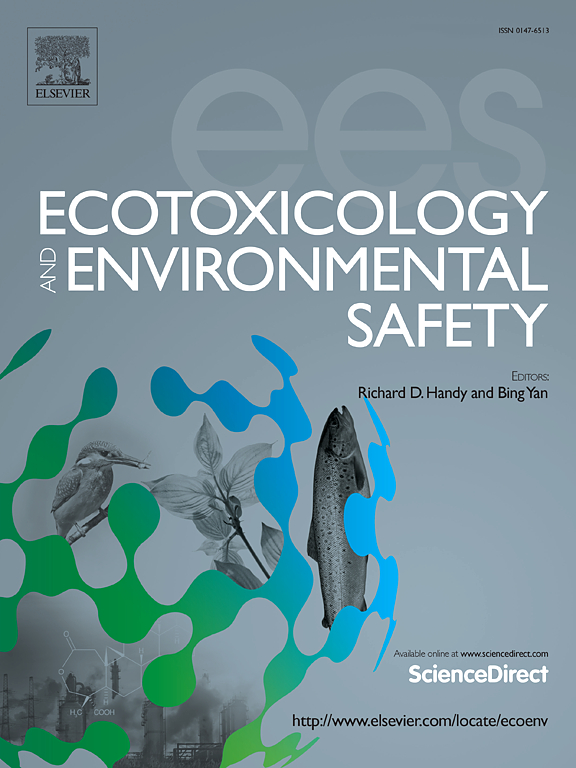中空玻璃微球对底栖和底栖生物小头螺和贻贝的影响
IF 6.2
2区 环境科学与生态学
Q1 ENVIRONMENTAL SCIENCES
引用次数: 0
摘要
中空玻璃微珠(HGM)作为填料广泛应用于涂料、塑料等复合材料中。此外,由于其高反射率,在北极海冰表面应用HGM的方法被认为是减少冰损失的一种措施,从而有助于减轻气候变化的影响。在这项研究中,我们研究了HGMs(平均尺寸为47 µm)对两种海洋物种——底栖多毛藻(polychaete Capitella sp.)和滤食性蓝贻贝Mytilus edulis的潜在影响。小头藻暴露于三种浓度的无浮力hgm(含和不含沉积物)(1、10和100 mg g−1沉积物等于0.1、1和10 g总hgm)。暴露42天后(幼年期到成年期),测定HGM的摄取、存活和生长。将成年Mytilus edulis暴露于三种浓度(1、10和100 mg L−1)的新鲜和生物混合HGM中10天,分析HGM的摄取、存活、状态指数、清除率、血细胞的细胞毒性和基因毒性损伤。结果表明,虽然两种物种都摄入了hgm,但对它们的生存没有显著影响。暴露于中等和高浓度的HGM环境中,无论是否存在沉积物,都会显著影响小头藻的生长和发育。相比之下,短期暴露于新鲜或生物污染的hgm对成虫的营养状况、状态指数和过滤能力没有影响。高浓度的生物掺杂HGMs确实在毛囊杆菌的细胞水平上引起轻微的反应,因为嗜酸性细胞计数减少。虽然在毛蕊草中的反应不太清楚,但HGM对Capitella的作用模式可能与能量收支的改变有关。需要进一步的研究来调查作用方式并确定潜在目标物种的效应阈值浓度。本文章由计算机程序翻译,如有差异,请以英文原文为准。
Effects of hollow glass microspheres on the benthic and benthopelagic organisms Capitella sp. and Mytilus edulis
Hollow glass microspheres (HGM) are widely used as fillers in composite materials including paints and plastics. Further, due to their high reflectivity, an approach involving HGM application on Arctic sea ice surfaces has been considered as a measure to reduce ice loss and thus help mitigate climate change effects. In this study we investigated potential impacts of HGMs (average size 47 µm) on two marine species, the benthic polychaete Capitella sp. and the filter feeding blue mussel Mytilus edulis. Capitella were exposed to three concentrations of non-buoyant HGMs with and without sediment (1, 10 and 100 mg g−1 sediment equalling 0.1, 1 and 10 g total HGMs). After a 42 day-exposure (juveniles to adult live stages), HGM uptake, survival and growth were determined. Adult Mytilus edulis were exposed for 10 days to three concentrations (1, 10 and 100 mg L−1) of fresh and biofouled HGMs, and HGM uptake, survival, condition index, clearance rate, cytotoxic and genotoxic damage in haemocytes were analysed. Results show that, while both species ingest HGMs, there were no significant impacts on survival. Exposure to medium and high HGM concentrations in presence and absence of sediment significantly impacted growth and development of Capitella. In contrast, the shorter-term exposure to fresh or biofouled HGMs did not affect the nutritional status, condition index or filtering capacity of adult M. edulis. High concentrations of biofouled HGMs did cause a slight response on cellular level in M. edulis, as eosinophilic cell counts decreased. While responses in M. edulis were less clear, the HGM mode of action on Capitella may be related to alterations in energy budget. Further studies are needed to investigate modes of action and determine effect threshold concentrations in potential target species.
求助全文
通过发布文献求助,成功后即可免费获取论文全文。
去求助
来源期刊
CiteScore
12.10
自引率
5.90%
发文量
1234
审稿时长
88 days
期刊介绍:
Ecotoxicology and Environmental Safety is a multi-disciplinary journal that focuses on understanding the exposure and effects of environmental contamination on organisms including human health. The scope of the journal covers three main themes. The topics within these themes, indicated below, include (but are not limited to) the following: Ecotoxicology、Environmental Chemistry、Environmental Safety etc.

 求助内容:
求助内容: 应助结果提醒方式:
应助结果提醒方式:


